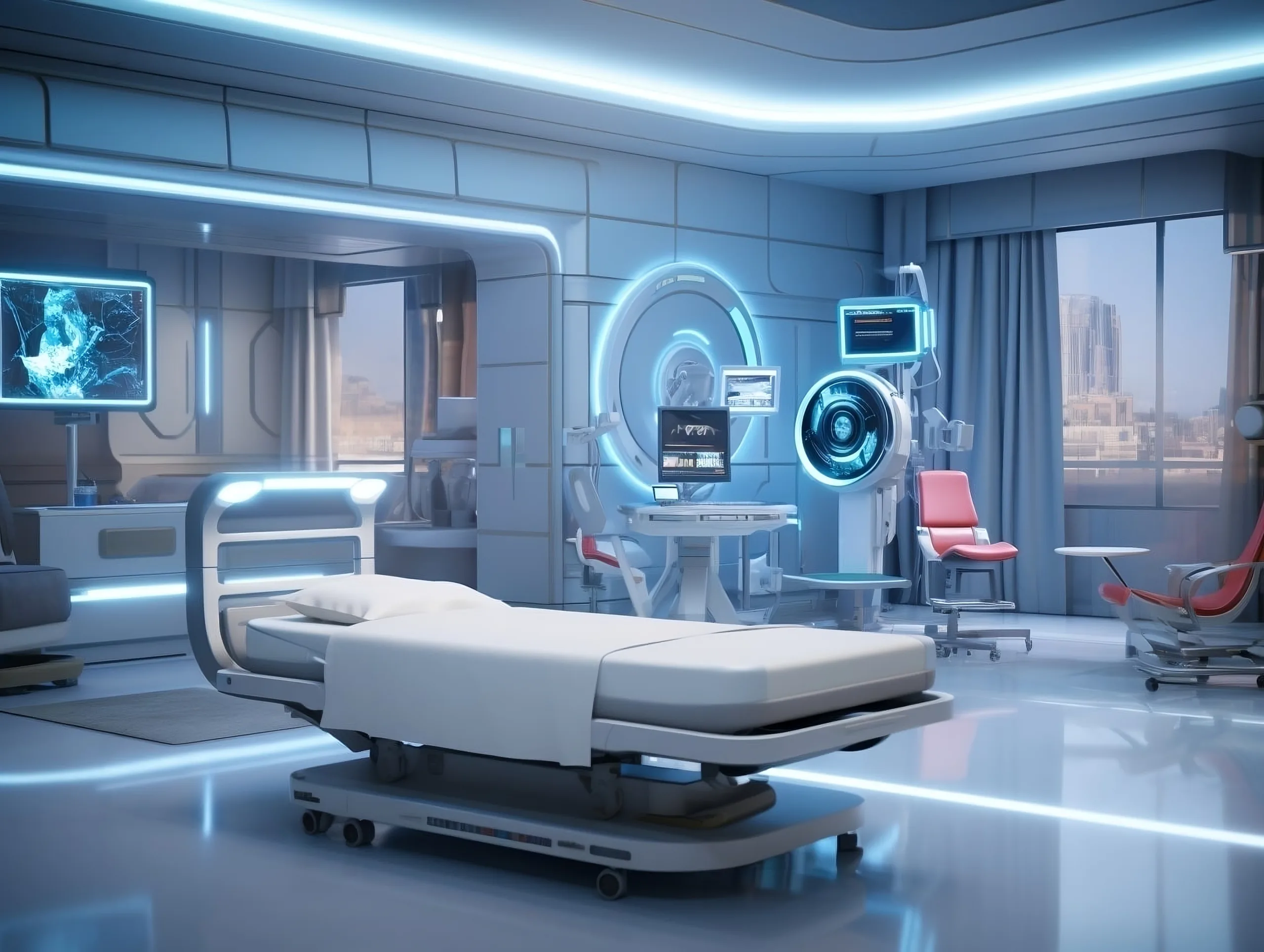Hospitals have always been a place of care and healing, but traditional hospitals often struggle with long wait times, overcrowding, medical errors, and outdated systems. Technology is solving these problems, giving birth to smart hospitals—highly automated, digital, and patient-centric healthcare facilities.
Smart hospitals integrate AI, IoT, robotics, telemedicine, and cloud-based systems to create a seamless patient experience. They reduce human errors, automate administrative work, enhance doctor-patient communication, and provide real-time health monitoring.
As we enter 2025, smart hospitals are no longer a futuristic concept—they are a reality. More hospitals worldwide are adopting smart technology to improve healthcare accessibility, efficiency, and safety.
Let’s take a closer look at what defines a smart hospital and how it differs from traditional medical facilities.
What Are Smart Hospitals? A New Era of Healthcare
A smart hospital is a technologically advanced medical facility that leverages digital solutions to enhance patient care, improve hospital efficiency, and optimize medical processes. Unlike traditional hospitals, smart hospitals rely on automation, real-time data sharing, and AI-driven decision-making.
Key Features of Smart Hospitals
✅ AI-Powered Diagnostics: AI helps in early disease detection and more accurate diagnosis.
✅ IoT-Enabled Monitoring: Smart devices track patient health in real-time and alert doctors if needed.
✅ Electronic Health Records (EHRs): Digital records eliminate paperwork and allow instant access to patient history.
✅ Robotic-Assisted Surgeries: Robots assist in complex procedures with precision and efficiency.
✅ Automated Hospital Management: AI automates scheduling, billing, and administrative tasks, reducing workload.
These advanced features ensure that patients receive faster, safer, and more personalized care.
The Role of AI and Automation in Smart Hospitals
AI and automation are at the heart of smart hospitals. They enhance efficiency, accuracy, and decision-making in patient care.
🔹 AI in Diagnostics: AI algorithms analyze medical images, detect diseases early, and provide treatment recommendations.
🔹 Automated Scheduling: AI-based systems schedule appointments and optimize patient flow, reducing wait times.
🔹 Smart Assistants: AI-powered chatbots answer patient queries, guide them to the right departments, and provide virtual support.
🔹 AI in Drug Discovery: AI speeds up the process of finding new medicines, making treatments available faster.
With AI and automation, hospitals run smoothly, reduce human errors, and provide better healthcare outcomes.

How Smart Hospitals Enhance Patient Experience
For patients, a hospital visit can be stressful. Long wait times, administrative delays, and lack of communication can make the experience frustrating. Smart hospitals change that by prioritizing patient comfort and convenience.
How Smart Hospitals Improve Patient Care
💡 Faster Check-ins & Appointments: AI-powered scheduling ensures quick and hassle-free appointments.
💡 Personalized Treatment Plans: AI analyzes patient history to provide tailored treatment recommendations.
💡 Remote Health Monitoring: Wearables and IoT devices track vital signs and alert doctors if necessary.
💡 Seamless Communication: Hospital apps and AI chatbots keep patients informed about their treatments and test results.
💡 Smart Hospital Rooms: Automated lighting, temperature control, and voice-activated assistants improve patient comfort.
These improvements make hospital visits less stressful, more efficient, and focused on patient well-being.
Key Technologies Powering Smart Hospitals in 2025
Several cutting-edge technologies drive the success of smart hospitals.
1. Artificial Intelligence (AI)
AI enhances diagnostics, treatment planning, and patient care. It helps doctors detect diseases faster and with higher accuracy.
2. Internet of Things (IoT)
IoT connects medical devices and allows real-time monitoring of patients. This ensures immediate action in case of emergencies.
3. Robotics
Robots assist in surgeries, drug delivery, and even patient rehabilitation. They enhance precision and reduce human error.
4. Blockchain Technology
Blockchain secures medical records, ensures data privacy, and prevents unauthorized access.
5. 5G Connectivity
Faster internet speeds enable seamless video consultations and instant access to cloud-based medical records.
These technologies create a smart, safe, and efficient healthcare environment.
Smart Hospitals vs. Traditional Hospitals: What’s the Difference?
| Feature | Traditional Hospitals | Smart Hospitals |
|---|---|---|
| Efficiency | Manual processes, slower response time | AI-driven automation, faster response |
| Data Access | Paper-based records, time-consuming | Digital records, instant access |
| Monitoring | Periodic check-ups | 24/7 real-time monitoring |
| Treatment | Generalized approach | Personalized, AI-driven treatments |
| Patient Comfort | Long waiting times, administrative hassle | Streamlined, tech-enhanced experience |
Clearly, smart hospitals provide a far more efficient and patient-friendly experience.
Telemedicine and Remote Monitoring: The Future of Patient Care
With telemedicine and remote monitoring, smart hospitals offer healthcare beyond physical walls.
📌 Virtual Consultations: Patients can consult doctors via video calls, reducing hospital visits.
📌 Wearable Health Devices: Smartwatches and fitness bands track heart rate, oxygen levels, and more.
📌 Home-Based Treatment: Chronic patients can receive care without traveling to hospitals.
These innovations make healthcare more accessible, especially for remote and elderly patients.
Smart hospitals lighten the burden on healthcare workers by automating repetitive tasks.
✔ Less Paperwork: AI handles documentation, reducing manual workload.
✔ Better Diagnoses: AI assists doctors in making faster and more accurate decisions.
✔ Improved Efficiency: Smart scheduling and automation free up time for patient care.
Doctors, nurses, and staff can focus more on saving lives rather than dealing with administrative tasks.
Challenges in Implementing Smart Hospitals
Despite their benefits, smart hospitals face several challenges:
🚧 High Costs: Implementing smart technology requires massive investment.
🚧 Cybersecurity Risks: Digital health records are vulnerable to hacking.
🚧 Training Needs: Staff must be trained to use new technologies efficiently.
Overcoming these challenges is essential for widespread smart hospital adoption.
The Future of Smart Hospitals: What to Expect Beyond 2025
The journey of smart hospitals is just beginning. In the future, we can expect:
🔮 AI-powered predictive medicine for disease prevention.
🔮 Fully automated hospitals with robotic assistance.
🔮 More advanced wearable devices for real-time health tracking.
🔮 Global smart healthcare access through telemedicine.
As technology evolves, healthcare will become faster, smarter, and more personalized.
Smart hospitals are the future of healthcare. They combine technology, automation, and AI to provide better patient experiences and improved medical outcomes.
By 2025, more hospitals will embrace smart technology, making healthcare safer, more efficient, and accessible to all.
Are you ready for the future of smart healthcare? 🚀

